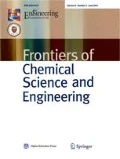Abstract
The response surface methodology was employed to study the optimization of microwave-assisted extraction of picroside I and picroside II from Picrorrhiza kurroa Royle rhizomes. The effects of solid to solvent ratio, and extraction temperature, time and solvent on the yields of picroside I and picroside II have been investigated using Box-Behnken experimental design. The experimental data were fitted to second-order polynomial equations using multiple regression analysis and analyzed using the appropriate statistical method. By solving the regression equation and analyzing 3-D plots, the optimum extraction conditions were found to be: solid to solvent ratio, 10: 90 (w/v); temperature, 60 °C; and extraction time, 60 s. Under the optimal conditions, the yields of picroside I and picroside II are 41.23 and 6.12 mg·g−1 feed respectively, which are in good agreement with the predicted values. The ratio of solid to solvent significantly affects the yields of picroside I and picroside II. Application of microwaveassisted extraction of picroside I and picroside II from P. kurroa would dramatically reduce extraction time and solvent consumption.
Similar content being viewed by others
References
Luper S. A review of plants used in the treatment of liver disease: Part 1. Alternative Medicine Review, 1998, 3(6): 410–421
Dhawan B N. Picroliv—a new hepatoprotective agent from an Indian medicinal plant, Picrorhiza kurroa. Medicinal Chemistry Research, 1995, 5 (8): 595–605
Singh G B, Bani S, Singh S, Kaul A, Khajuria A, Sharma M L, Gupta B D, Banerjee S K. Anti-inflammatory activity of the iridoids kutkin, picroside-I and kutkoside from Picrorhiza kurroa. Phytotherapy Research, 1993, 7(6): 402–407
Recio D C, Maria M, Ginger R, Manez S, Rios J L. Structural considerations on the iridoids as anti-inflammatory agents. Planta Medica, 1994, 60(3): 232–234
Atal C K, Sharma M L, Kaul A, Khajuria A. Immunomodulating agents of plant origin. I: Preliminary screening. Journal of Ethnopharmacology, 1986, 18(2): 133–141
Puri A, Saxena R P, Sumati Guru P Y, Kulshreshtha D K, Saxena K C, Dhawan B N. Immunostimulant activity of picroliv, the iridoid glycoside fraction of Picrorhiza kurroa, and its protective action against Leishmania donovani infection in Hamsters. Planta Medica, 1992, 58(6): 528–532
Chander R, Kapoor N K, Dhawan B N. Picroliv, picroside-I and kutkoside from Picrorhiza kurrooa are scavengers of superoxide anions. Biochemical Pharmacology, 1992, 44(1): 180–183
Girish C, Koner B C, Jayanthi S, Ramchandrarao K, Rajesh B, Pradhan S C. Hepatoprotective activity of picroliv, curcumin and ellagic acid compared to silymarin on paracetamol induced liver toxicity in mice. Fundamental & Clinical Pharmacology, 2009, 23(6): 735–745
Kiso Y, Tohkin M, Hikino H. Assay method for antihepatotoxic activity using galactosamine induced cytotoxicity in primary cultured hepatocytes. Journal of Natural Products, 1983, 46(6): 841–847
Kitagawa I, Hino K, Nishlmura T, Iwata E, Yosioka I. On the constituents of Picrorhiza kurrooa. (1). The structure of picroside I, a bitter principle of the subterranean part. Chemical & Pharmaceutical Bulletin, 1971, 19(12): 2534–2544
Tiwari S S, Pandey M M, Srivastava S, Rawat A K S. TLC densitometric quantification of picrosides (picroside-I and picroside-II) in Picrorhiza kurroa and its substitute Picrorhiza scrophulariiflora and their antioxidant studies. Biomedical Chromatography, 2012, 26(1): 61–68
Gaikwad P S, Bhope S G, Kuber V V, Patil M J. Validated TLC method for simultaneous quantitation of kutkoside and picroside-I from kutki extract. Phytochemical Analysis, 2011, 22(1): 36–41
Bhandari P, Kumar N, Singh B, Kaul V K. Simultaneous determination of sugars and picrosides in Picrorhiza species using ultrasonic extraction and high-performance liquid chromatography with evaporative light scattering detection. Journal of Chromatography. A, 2008, 1194(2): 257–261
Wakte P S, Sachin B S, Patil A A, Mohato D M, Band T H, Shinde D B. Optimization of microwave, ultra-sonic and supercritical carbon dioxide assisted extraction techniques for curcumin from Curcuma longa. Separation and Purification Technology, 2011, 79 (1): 50–55
Eskilsson C S, Bjorklund E. Analytical-scale microwave assisted extraction. Journal of Chromatography A, 2000, 902(1): 227–250
Box G E P, Hunter W G, Hunter J S. Statistics for Experimenters. New York: Wiley, 1997
Montgomery D C. Design and Analysis of Experiments. 4th ed. New York: Wiley, 1997
Patil A A, Bhusari S S, Wakte P S, Shinde D B. Optimization of sample preparation variables for wedelolactone from Eclipta alba using Box-Behnken experimental design followed by HPLC identification. Annales Pharmaceutiques Francaises, 2013, 71(4): 249–259
Patil A A, Bhusari S S, Wakte P S, Shinde D B. Study of supercritical fluid extraction and ionic liquids as an additive on picroside I and picroside II recovery from Picrorhiza scrophulariiflora rhizomes. Journal of Pharmaceutical Investigation, 2013, 43(3): 215–228
Machmudah S, Kawahito Y, Sasaki M, Goto M. Supercritical CO2 extraction of rosehip seed oil: Fatty acids composition and process optimization. Journal of Supercritical Fluids, 2007, 41(3): 421–428
Murphy E J. Ionic conduction in hydrogen bonded solids. Annals of the New York Academy of Sciences, 1965, 118(19 Ionic Conduc): 728–738
Pethig R. Dielectric and Electronic Properties of Biological Materials. Chichester: Wiley, 1979
Chan C H, Yusoff R, Ngoh G C, Kung F W L. Microwave-assisted extractions of active ingredients from plants. Journal of Chromatography A, 2011, 1218(37): 6213–6225
Mandal V, Mohan Y, Hemalatha S. Microwave assisted extraction—an innovative and promising extraction tool for medicinal plant research. Pharmacognosy Reviews, 2007, 1(1): 7–18
Author information
Authors and Affiliations
Corresponding author
Rights and permissions
About this article
Cite this article
Wakte, P., Patil, A., Sachin, B. et al. Optimization of microwave-assisted extraction for picroside I and picroside II from Picrorrhiza kurroa using Box-Behnken experimental design. Front. Chem. Sci. Eng. 8, 445–453 (2014). https://doi.org/10.1007/s11705-014-1458-2
Received:
Accepted:
Published:
Issue Date:
DOI: https://doi.org/10.1007/s11705-014-1458-2




